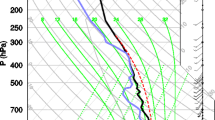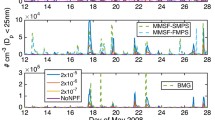Abstract
A simple entraining air parcel model including cloud microphysical and chemical processes is used to calculate the distribution of sulfate over the drop sizes under continental background conditions. Under these conditions the aerosol sulfate is predicted to contribute the largest amount of aqueous sulfate in cloud drops. The sulfate produced by oxidation is found to contribute significantly in drops larger than 10 μm radius.
Similar content being viewed by others
References
Ayers G.P. and Larson T.V. (1990) ‘Numerical study of droplet size dependent chemistry in oceanic, wintertime stratus cloud at southern mid-latitudes’. J. Atm. Chem. 11, 143–167.
Durham J.L., Overton J.H. and Aneja V.P. (1981) ‘Influence of gaseous nitric acid on sulfate production and acidity in rain’, Atm. Env. 15, 1059–1068.
Erickson R.E., Yates L.M., Clard R.L. and McEwen C.M. (1977) ‘The reaction of sulfur dioxide with ozone in water and its possible atmospheric significance’, Atm. Env. 11, 813–817.
Flossmann A.I., Hall W.D. and Pruppacher H.R. (1985) ‘A theoretical study of the wet removal of atmospheric pollutants. Part I: The redistribution of aerosol particles captured through nucleation and impaction scavenging by growing cloud drops’, J. Atm. Sci. 42, 583–606.
Flossmann A.I., Pruppacher H.R. and Topalian J.H. (1987) ‘A theoretical study of the wet removal of atmospheric pollutants. Part II: The uptake and redistribution of (NH4)SO4 particles and SO2 gas simultaneously scavenged by growing cloud drops’, J. Atm. Sci. 44, 2912–2923.
Hall W.D. (1980) ‘A detailed microphysical model within a two-dimensional framework: Model description and preliminary results’, J. Atm. Sci. 37, 2486–2507.
Hänel G. (1987) ‘The role of aerosol properties during the condensational stage of cloud: A reinvestigation of numerics and microphysics’, Beitr. Phys. Atmosph. 60, 321–339.
Hegg D.A. and Larson T.V. (1990) ‘The effects of microphysical parameterisation on model predictions of sulfate production in clouds’, Tellus 42B, 272–284.
Hegg D.A., Rutledge S.A. and Hobbs P.V. (1986) ‘A numerical model for sulfur and nitrogen scavenging in narrow cold-frontal rainbands. 2. Discussion of chemical fields’, J. Geophys. Res. 91, 14403–14416.
Hoffmann M.R. (1986) ‘On the kinetics and mechanism of oxidation of aquated sulfur dioxide by ozone’, Atm. Env. 20, 1145–1154.
Iribarne J.V. and Cho H.R. (1989) ‘Models of cloud chemistry’, Tellus 41B, 2–23.
Leaitch W.R., Strapp J.W., Wiebe H.A., Anlauf K.G. and Isaac G.A. (1986) ‘Chemical and microphysical studies of nonprecipitating summer cloud in Ontario, Canada’, J. Geophys. Res. 91, 11821–11831.
Lee I.Y. (1986) ‘Numerical simulation of chemical and physical properties of clouds’, Atm. Env. 20, 767–771.
Lee I.Y., Hänel G. and Pruppacher H.R. (1980) ‘A numerical determination of the evolution of cloud drop spectra due to condensation on natural aerosol particles’, J. At. Sci. 37, 1839–1853.
Martin L.R. and Damschen D.E. (1981) ‘Aqueous oxidation of sulfur dioxide by hydrogen peroxide at low pH’, Atm. Env. 15, 1615–1621.
Nair S.K. and Peters L.K. (1989) ‘Studies on non-precipitating cumulus cloud acidification’, Atm. Env. 23, 1399–1423.
Noone K.J., Charlson R.J., Covert D.S., Ogren J.A. and Heintzenberg J. (1988) ‘Cloud droplets: Solute concentration is size dependent’, J. Geophys. Res. 93, 9477–9482.
Ogren J.A., Heintzenberg J. Zuber A. and Noone K.J. (1989) ‘Measurements of the size-dependence of solute concentrations in cloud droplets’, Tellus 41B, 24–31.
Pandis S.N. and Seinfeld J.H. (1989) ‘Sensitivity analysis of a chemical mechanism for aqueous-phase atmospheric chemistry’, J. Geophys. Res. 94, 1105–1126.
Pandis S.N., Seinfeld J.H. and Pilinis C. (1990) ‘Chemical composition differences in fog and cloud droplets of different sizes’, Atm. Env. 24A, 1957–1969.
Pruppacher H.R. and Klett J.D. (1978) Microphysics of clouds and precipitation, D. Reidel, Dordrecht
Saxena P. and Seigneur C. (1987) ‘On the oxidation of SO2 to sulfate in atmospheric aerosols’, Atm. Env. 21, 807–812.
Seidl W. (1989) ‘Ionic concentrations and initial S(IV)-oxidation rates in droplets during the condensational stage of cloud’, Tellus 41B, 32–50.
Seigneur C. (1987) ‘Computer simulation of air pollution chemistry’, Env. Softw. 2, 116–127.
Taylor G.R. (1989) ‘Sulfate production and deposition in midlatitude continental cumulus clouds. Part I: Cloud model formulation and base run analysis’, J. Atm. Sci. 46, 1971–1990.
Tremblay A. (1987) ‘Cumulus cloud transport, scavenging and chemistry: observations and simulations’, Atm. Env. 21, 2345–2364.
Twohy C.H., Austin P.H. and Charlson R.J. (1989) ‘Chemical consequences of the initial diffusional growth of cloud droplets: a clean marine case’, Tellus 41B, 51–60.
Walcek C.J. and Taylor G.R. (1986) ‘A theoretical method for computing vertical distributions of acidity and sulfate production within cumulus clouds’, J. Atm. Sci. 43, 339–355.
Author information
Authors and Affiliations
Rights and permissions
About this article
Cite this article
Roelofs, G.J.H. Drop size dependent sulfate distribution in a growing cloud. J Atmos Chem 14, 109–118 (1992). https://doi.org/10.1007/BF00115227
Published:
Issue Date:
DOI: https://doi.org/10.1007/BF00115227




